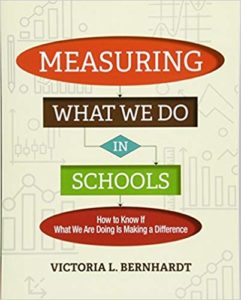Measuring What We Do in Schools
Measuring What We Do in Schools: How to know if what we are doing is making a difference
By Victoria L. Bernhardt
(ASCD, 2017 – Learn more)

Measuring What We Do in Schools provides a model for how a school can evaluate and reconfigure its plan for continuous school improvement. Throughout the text there are clear and practical descriptions of how schools can take steps towards becoming true learning organizations.
Victoria L. Bernhardt provides relevant suggestions for schools to implement as well as examples of how implementation was carried out in actual schools. The implementation examples cover all school levels. This book is for teachers and administrators, both preservice and inservice professionals.

If a school is not measuring or examining how well a program is being implemented, the program can’t be said to truly be in place within the school. Continuous evaluation of programs and even more importantly, school processes are critical.
Chapter 1, “Measuring What We Do in Schools,” begins with common misconceptions related to data analysis at the school level. Bernhardt conveys the idea that “evaluating our systems, processes, practices, and programs” is the next step in measuring how our school performs. The chapter includes an overview of what the text continues to address: learning organizations, continuous school improvement, systems thinking, and program evaluation.
In Chapter 2, “The Continuous School Improvement Framework: A Guide to Evaluation with Systems Thinking,” Bernhardt mentions five simple and critical questions for schools to reflect on in order to maximize outcomes for students and teachers:
1. Where are we now?
2. How did we get to where we are now?
3. Where do we want to be?
4. How are we going to get to where we want to be?
5. Is what we are doing making a difference?
This requires schools to examine their culture from the inside out by soliciting feedback from school personnel, students, and parents. This self-examination process allows a school to create a vision that will determine its direction and path.
In Chapter 3, “Evaluating Programs,” Bernhardt addresses common excuses schools have for not evaluating existing processes and programs. There are beneficial figures in this chapter highlighting the advantages and disadvantages of internal versus external evaluations. Starting in this chapter there are ready-to-use outlines of tables for schools to begin program evaluation. Several completed sample program evaluation tools are included throughout the chapter.
In order to address the issue of schools and teachers primarily sticking to data from high-stakes testing, Bernhardt makes the case that schools really need to be measuring processes, not strictly performance outcomes. Chapter 4, “Measuring Hard-to-Measure Processes,” describes an essential and simple solution for teachers and administrators to achieve this objective, using planning tables and flow charts.
Chapter 5, “How Can We Evaluate the Entire Learning Organization?,” presents “The Logic Model.” In this model, a school outlines their inputs, processes, and outcomes. The inputs are demographics, student learning, perceptions and school processes. The processes include anything that a school does that the staff believes should be implemented schoolwide to achieve desired outcomes. The outcomes may be short-term, intermediate, or long-term for students, staff, and families. An example of a middle school’s completed Logic Model is included in this section.
Chapter 6 provides suggestions for first steps schools can take to become learning organizations. These steps are then modeled through an actual example in Chapter 7, “Pulling It All Together: A Case Study.” Bernhardt explains how over the course of three years a high school began to focus on continuous school improvement. The first phases place emphasis on data analysis with the entire staff meeting to analyze demographic data, in a process that took just 15 minutes. The next step, taking 45 minutes, involved working in small groups to discuss strengths, challenges, and implications of the demographic data for a continuous school improvement plan. This school went on to use the framework, became a true learning organization through constant evaluation and improvement, and is no longer a state-identified “focus school.”
A must read for school decision makers
As a former school leadership team member, teacher, support staff member, and Title I facilitator, I recommend this book as a must read for anyone involved in school level decision making. Bernhardt provides ready-to-use guides with actual school examples that will lead your school to become a true learning organization. This book will make you question what data your school should really be using and guide you through the process of changing the way your school does business.
Scott Holcomb is a doctoral student at the University of North Carolina at Charlotte. He has over 12 years of experience working in various capacities in elementary schools. He has expertise in early childhood and elementary teaching, school leadership, assessment, and school readiness. He is furthering his education with a doctorate in Educational Research, Measurement, and Evaluation to prepare teachers and administrators to use data to inform their decisions in classrooms, schools, and districts.



































